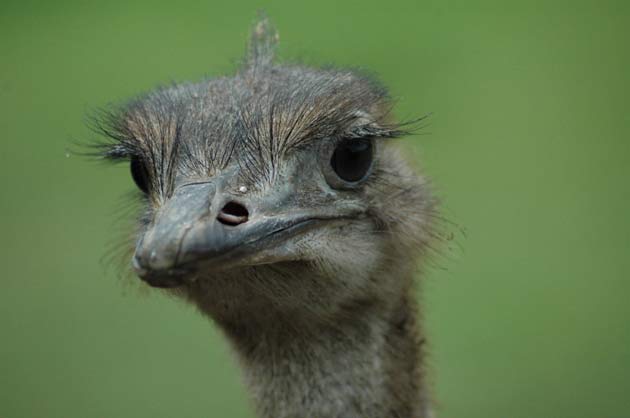Odd Body, Great Legs, Running Like the Wind

The egg-shaped torsos of ostriches might, to the untrained eye, make them ungainly runners.
But new findings suggest their odd figures instead help the flightless birds maneuver gracefully while running. Researchers say their work could eventually help give patients with spinal cord damage improved odds for better locomotion.
Arizona State University comparative biomechanist Devin Jindrich has spent several years developing mathematical models to predict how animals maneuver, based on details such as body mass, inertia, running speed and leg placement. He verified his models with the six-legged scuttling of cockroaches and the bipedal running of humans.
Still, when it comes to evolution, humans are relatively new to bipedalism compared to other organisms that have been on Earth far longer. Jindrich and his colleagues in Britain wanted to see how well the model worked on flightless birds, which are millions of years more accustomed to upright running than humans. These birds run either to escape predators or, in the case of the ancient terror birds, to hunt prey.
The scientists trained eight ostriches to run down a 75-foot rubber path and over a plate halfway down the runway that measured the force with which their feet hit the ground. They also used eight cameras around the platform to record the locations of reflective markers placed on the ostrich bodies. Motion capture software, much like that used to make such movies as the "Lord of the Rings" trilogy, then analyzed the placement of these markers to track ostrich body and joint positions.
Look out!
The birds were made to run either in a straight line or around obstacles, such as a cardboard box placed immediately after the force plate, which caused the ostriches to change direction to dodge the object. However, the researchers faced a number of difficulties persuading the flightless birds to do what they wanted.
Get the world’s most fascinating discoveries delivered straight to your inbox.
"This meant shaking a plastic bag behind them to encourage them to run—they didn't like the noise—and carefully positioning the experimenters around the room so the birds didn't get startled," Jindrich recalled. "The consequences of misreading the birds could be grave. On a couple of occasions, they got confused and ran right through the computers and camera system. Luckily nothing was broken, but it was a close call."
Easy maneuvering
To make successful turns, a runner must not over-rotate. Humans decelerate to prevent over-rotation, but the scientists found that on average ostriches decelerated with less effort as they swerved.
"The ostriches seem to be shaped in such a way that makes maneuvering 'easy,'" Jindrich told LiveScience.
According to Jindrich's calculations, the egg-shaped, horizontally oriented body of the ostrich has higher inertia as it runs than the more vertical human body shape. This makes the ostrich body harder to rotate and less likely to over-rotate than humans. The birds alter their direction simply by rolling their bodies into turns.
"These findings have relevance to understanding why terrestrial animals are shaped the way they are," Jindrich said. He and his colleagues will detail their findings in the April 15 issue of the Journal of Experimental Biology.
Help for injuries
Jindrich is now working to apply these findings to improve locomotion after injury. The ideas include electronic systems that stimulate muscles and nerves.
"I aim to develop biomechanics-based controllers that will help people with injuries maneuver and remain stable during locomotion," Jindrich said.
Jindrich added his work could also help improve physical therapy.
"By better understanding maneuverability and stability, I hope to improve rehabilitation training, since maneuvering and stability are essential to successful locomotion," he said.
Georgia Institute of Technology comparative physiologist Young-Hui Chang said he was excited that the models for controlling maneuverability developed by Jindrich and his colleagues are bearing out now in several different species.
"If you can understand the simple physical rules that animals must follow to accomplish movement, then you can begin to manipulate the variables to generate new ideas," he explained, not just for physical therapy but for "autonomous legged robots and vehicles."

